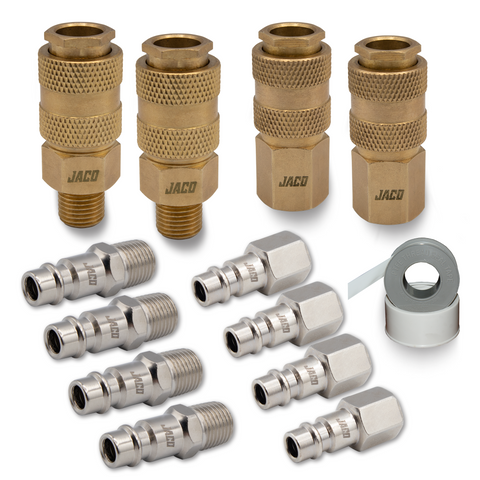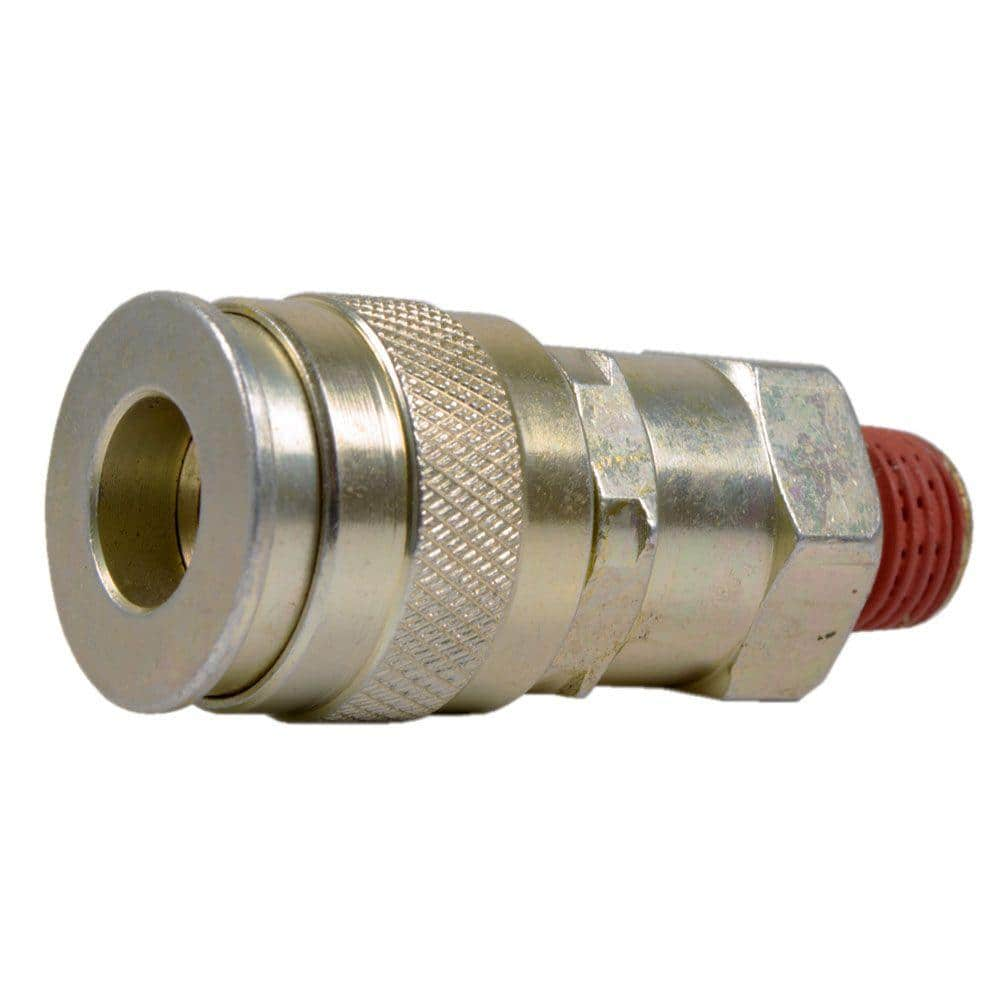If you use an air compressor regularly, you know how frustrating it can be to switch tools or hoses quickly. That’s where an air compressor quick connect hose makes a huge difference.
Imagine saving time and effort every time you need to connect or disconnect your air tools. This simple accessory can boost your work speed and reduce hassle. Ready to discover how this small change can make your projects smoother and more efficient?
Keep reading to find out everything you need to know about air compressor quick connect hoses.

Credit: jacosuperiorproducts.com
Benefits Of Quick Connect Hoses
Quick connect hoses offer many benefits for air compressor users. These hoses make tasks faster and easier. They help save time and reduce hassle during setup. Their design supports many tools and machines. Using quick connect hoses improves work efficiency and comfort.
Time-saving Setup
Quick connect hoses allow fast attachment to compressors. No need for screwing or twisting. This speeds up starting work. Changing tools takes only seconds. Workers spend less time preparing and more time working.
Ease Of Use
These hoses connect with a simple push or pull. No special skills required. The process feels natural and smooth. Even beginners can handle them easily. This reduces frustration and mistakes on the job.
Versatility And Compatibility
Quick connect hoses fit many different air tools. They work with various compressor models. This flexibility makes them useful in many situations. Users do not need multiple hoses for different tasks.
Types Of Quick Connect Fittings
Quick connect fittings for air compressor hoses come in different types. These fittings make attaching and detaching hoses faster and easier. Knowing the types helps choose the right one for your task. The main differences lie in design, material, and size. Each type suits specific needs and tools.
Industrial Vs. Automotive
Industrial quick connect fittings are built for heavy use. They handle high pressure and last longer. Automotive fittings fit smaller tools and lower pressure needs. Industrial types often have stronger locking systems. Automotive fittings focus on convenience and speed. Choose industrial for factories and automotive for car shops.
Material Variations
Quick connect fittings come in brass, steel, and plastic. Brass is common and resists rust well. Steel fittings are stronger but heavier. Plastic fittings are light and cheap but less durable. The material affects the fitting’s life and strength. Pick the material based on your work environment.
Size And Thread Options
Fittings come in various sizes and thread types. Common sizes include 1/4 inch and 3/8 inch. Threads can be NPT, BSP, or metric. The size and thread must match your hose and tool. Proper fit prevents air leaks and keeps pressure steady. Check size and thread before buying fittings.
Choosing The Right Hose
Choosing the right air compressor quick connect hose is key for efficient work. The hose must fit your tools and meet your job needs. A wrong choice can cause leaks or poor air flow. Focus on three main factors to pick the best hose.
Length And Diameter Considerations
The hose length affects your reach and ease of use. A short hose limits movement. A very long hose can reduce air pressure. Choose a length that fits your workspace and tasks.
Diameter matters for air flow. Larger diameters allow more air to pass. This supports high-demand tools better. Match the diameter to your air compressor and tool needs.
Pressure Ratings
Check the hose’s pressure rating before buying. It shows the maximum air pressure the hose can handle safely. Use a hose with a rating higher than your compressor’s pressure. This prevents bursts and accidents.
Durability And Flexibility
Durable hoses last longer under tough conditions. Look for materials that resist wear, such as rubber or reinforced PVC. Flexibility helps the hose move easily around corners and tight spaces. Choose a hose that bends without kinking or cracking.

Credit: www.homedepot.com
Installation Steps
Installing an air compressor quick connect hose is simple and fast. Follow clear steps to ensure a secure connection. Proper installation helps avoid air leaks and keeps your tools working well.
Preparing The Compressor And Hose
Turn off the air compressor and unplug it from power. Release any air pressure in the tank by opening the drain valve. Check the hose and fittings for damage or dirt. Clean the connection points to ensure a tight fit.
Attaching Quick Connect Fittings
Select the correct quick connect fitting for your hose and compressor. Push the fitting firmly into the hose end. Tighten any clamps or screws to hold the fitting in place. Connect the other fitting to the air compressor outlet. Make sure both fittings click or lock securely.
Testing For Leaks
Turn on the air compressor and pressurize the hose. Listen closely for any hissing sounds near connections. Apply soapy water to fittings and watch for bubbles. Bubbles mean air is escaping and fittings need tightening. Fix leaks before using the hose for tools.
Maintenance Tips
Proper maintenance keeps your air compressor quick connect hose working well. It extends the hose life and prevents leaks. Simple care steps can save time and money. Follow these tips to keep the hose in top shape.
Cleaning Connectors
Clean the connectors regularly to remove dirt and dust. Use a soft cloth or brush for gentle cleaning. Avoid water inside the connectors to prevent rust. Clean connectors ensure a tight and secure fit every time.
Checking For Wear And Tear
Inspect the hose and connectors for cracks or damage. Look for signs of fraying or hard spots on the hose. Replace parts that show wear to avoid air leaks. Regular checks help maintain safety and performance.
Storing The Hose Properly
Store the hose in a cool, dry place away from sunlight. Coil the hose loosely to prevent kinks and bends. Avoid hanging the hose by the connectors. Proper storage keeps the hose flexible and ready to use.
Troubleshooting Common Issues
Troubleshooting common issues with air compressor quick connect hoses helps maintain smooth operation. Problems like leaks, connection failures, and pressure drops can reduce efficiency. Identifying these issues early saves time and avoids costly repairs. Below are simple steps to fix these common problems.
Air Leaks
Air leaks waste power and lower pressure. Check the hose and connectors for cracks or holes. Use soapy water on connections to spot bubbles that show leaks. Tighten loose fittings carefully. Replace damaged hoses or seals to stop leaks quickly.
Connection Failures
Loose or faulty connections cause the hose to disconnect during use. Inspect the quick connect couplers for dirt or wear. Clean the couplers and apply a small amount of lubricant if needed. Make sure the hose locks firmly in place before use. Replace broken couplers to ensure a secure fit.
Pressure Drops
Pressure drops reduce the tool’s power and efficiency. Check for blockages in the hose or connectors. Clean any debris or dirt inside the hose. Verify the compressor settings match the tool’s pressure requirements. Replace old or worn hoses that cause pressure loss.
Popular Brands And Models
Choosing the right air compressor quick connect hose is important for smooth work. Different brands offer various models that fit many needs. Some focus on durability, while others offer flexibility or easy use. Knowing popular brands and their models helps make better choices.
Top-rated Quick Connect Hoses
Several hoses earn top ratings for quality and performance. Brands like Milton, Flexzilla, and Goodyear stand out. These hoses feature strong materials and reliable fittings. They resist kinks and last long in tough conditions. Professionals and hobbyists trust these brands for daily tasks.
Customer Favorites
Many buyers prefer hoses that combine ease and value. Flexzilla’s hose is light and flexible, making it easy to handle. Milton’s models often get praise for secure connections and durability. Customers like hoses that work well without extra effort. Reviews show these hoses meet most home and shop needs.
Budget Vs. Premium Options
Budget hoses suit occasional use and small jobs. They are affordable but may wear out faster. Premium hoses cost more but offer longer life and better features. They resist weather and rough handling better. Choosing depends on how often and where you use the hose. Spending a bit more can save money over time.

Credit: www.amazon.com
Frequently Asked Questions
What Is An Air Compressor Quick Connect Hose?
An air compressor quick connect hose allows fast and easy attachment or removal of air tools. It saves time and improves efficiency during work.
How Does A Quick Connect Hose Improve Air Tool Use?
It provides a secure, leak-free connection that enables swift tool changes. This minimizes downtime and enhances productivity on job sites.
Can I Use Any Quick Connect Hose With My Compressor?
No, hoses must match the compressor’s fittings and pressure ratings. Using compatible hoses ensures safety and optimal air flow performance.
What Materials Are Common For Quick Connect Hoses?
PVC, rubber, and polyurethane are popular materials. Each offers flexibility, durability, and resistance to abrasion or weather conditions.
Conclusion
Choosing the right air compressor quick connect hose saves time and effort. It makes attaching tools fast and easy. A good hose lasts longer and keeps air pressure steady. Always check the size and material before buying. This helps avoid leaks and damage.
Simple tools work better with the right hose. Remember, a small detail can improve your whole project. Keep your work smooth and efficient with the right connection. Easy to use, easy to change. That’s the key to better work.

